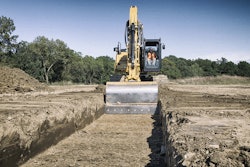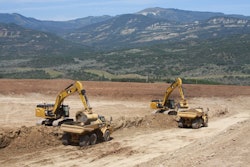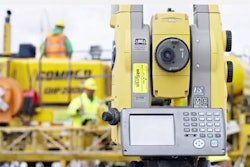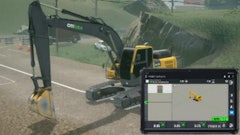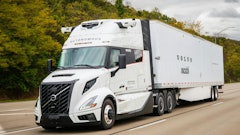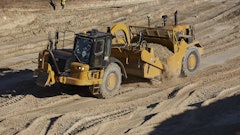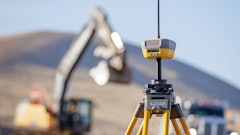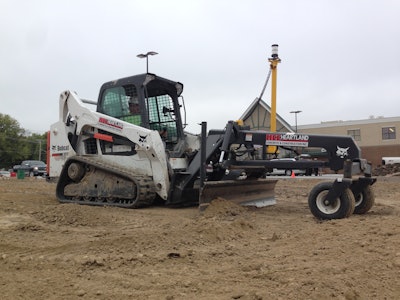
Heartland Concrete Construction, Hastings, NE, had been hired to finish-grade and concrete pave a 100,000-sq.-ft. parking lot being built for a new grocery store. The job turned out to be much more difficult than advertised – and then some. “It was a disaster,” says Beau Wissing.
Heartland is primarily a flatwork company with about 70% of its business involving concrete paving in commercial applications such as parking lots. It also handles flooring for larger commercial facilities and does a bit of residential work. It has been in business since 1993, when Jeff Wissing opened up shop. Beau now owns the business with his father.
“This was without a doubt the most complex parking lot we’ve ever done,” Beau Wissing comments. “There were valleys and ridges and crazy stuff all over. The elevations were off – nothing matched. The engineer had been fired. The plans made no sense.”
That was the good news. “The entry was unworkable,” he continues. “It was the worst part of the whole project. There was an approach that had a ridiculous elevation change.”
The general contractor told Wissing to take whatever steps necessary to move forward. Yet Heartland is a small firm with limited resources. So what does a contractor do, when a job is falling apart – and fixing it is up to you?
Preparing for Re-entry
Heartland turned to the Trimble Business Center – HCE system to re-engineer the entry. Trimble SCS900 Site Controller Software and a universal total station helped overcome many of the other engineering and surveying problems on the jobsite.
“Without that technology, I don’t know what we would have done,” Wissing states. “We’re a small contractor. It’s not like I have an engineering department I can call.”
The technology is built to provide productivity, and Wissing has seen those results firsthand. “What took a crew of 10 more than a week is now done with a crew of six in a day,” he comments. But on this project, the impact of the technology went beyond productivity.
The first step was re-engineering the approach. “There was a curb run of 150 ft. with 3 ft. of fall,” says Wissing. “The engineer designed it so 2 1/2 ft. of slope were in the first 20 ft. The last 90 ft. had 4 in. of fall.”
The result would have been a very steep drop-off for entering vehicles, and transition problems in many other places. “With some areas of the lot, we knew we could make adjustments that would work,” Wissing says. “With the entrance, we needed new engineering.”
Wissing turned to SITECH Mid-Plains and its design team. “The rep at SITECH Mid-Plains designed it,” says Wissing. “We worked on it together in Business Center - HCE. Then we could see it in 3D and make sure everything was flowing. We actually made it constructible, which was a miracle.
“Once it was designed in Business Center - HCE, we just went out and created it," he adds. "We were able to finish quickly, too.”
There were challenges in other areas of the parking lot that the universal total station and Trimble machine control were used to address. “I could drop the blade to the dirt level, and the readout would say add material or take some away,” Wissing notes. “If the re-work was extensive, we had another machine handle it. He would get it close, and I would come back and blade it with the Bobcat with the GCS900 [3D grade control].
“It’s not my preferred process but it did make for a quick recovery," he says.
Productivity Pays for Itself
The firm utilizes the universal total station and GCS900 on a Bobcat compact track loader, which is a customized grade control configuration that SITECH Mid-Plains set up. “Phil Hoppe at SITECH Mid-Plains listened to our needs and then went back to the office and came up with a completely customized, perfect solution,” Wissing states. “We have an 8-ft. grader attachment on the front of the track loader. All controls are automatic. Really, it’s the same setup as the big road graders.”
On most jobsites, a Heartland operator simply makes a pass with the automated grade control engaged to reach finish grade. “No concrete contractor of our size in this area is using this,” Wissing boasts.
Since adding the grader attachment, Heartland has started contracting out the company’s fine grading service to other construction firms. “We are so excited to have 3D automatic control on a compact grader,” he says. “It is truly an awesome system.
“On the universal total station side of it, we are transitioning more toward big commercial jobs where accuracy is really important, so that was a consideration,” Wissing comments. “These buildings have anchor bolts that have to be within 1/8 of an in.”
Yet the building can be several hundred feet long. “Stringline can bend a couple inches over that distance,” says Wissing. “People have been doing it with stringline forever, and it works. But I don’t think the old way is the best way.”
The productivity numbers have proven impressive. Wissing cites a recent 30,000-sq.-ft. job as an example. Previously, it would have required a week to a week and a half of fine grading, with a crew of 10 required for the layout, grading and stakeout.
That changed with the use of the GCS900 and SCS900. “Instead of a week or longer, the work was finished in a single day," says Wissing. "And even that day required only six workers, not the previous 10."
The system has exceeded expectations. “It pays for itself quickly," says Wissing. "We just hoped that the time saved and productivity would be a good investment. Now, a few months later, we can’t believe how good that investment is.
“It’s changed everything – our outlook on bidding, everything," he adds. Project managers are also impressed — and sometimes puzzled — by the setup. “We show up and they say, ‘Hey, where’s the rest of your crew?’ I say, ‘Just relax. Trust me.’ In a few hours we’re done — and they can’t believe it.”




![[Video] Trimble GCS900 Grade Control for Bobcat Grader Attachments](https://img.forconstructionpros.com/files/base/acbm/fcp/image/2016/08/default.57b2401bbc4da.png?auto=format%2Ccompress&fit=crop&h=167&q=70&w=250)
